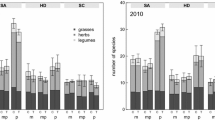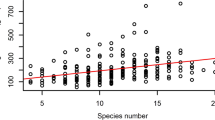Abstract
A positive relationship between plant species richness and ecosystem functioning has been found in a number of experimental studies. Positive species interactions at high species numbers have been suggested as a cause, but mechanisms driving positive interactions have not often been tested. In this experiment we asked three questions: (1) What is the relationship between species richness and productivity in experimentally constructed moss communities? (2) Is this relationship affected by plant density? and (3) Can changes in moisture absorption and retention explain observed relationships? To answer these questions we exposed arctic tundra moss communities of different species richness levels (1–11 species) and two different densities in the greenhouse to two levels of drought (short and long). Biomass (by the community and individual species), height and community moisture absorption and retention were measured as response variables. High species diversity increased productivity (more so in low-density plots than in high-density plots), but only when plots were watered regularly. Plot moisture retention was improved at high species richness as well, and plant height and variation in height was increased compared to plants in monoculture. Under high-density and short-drought conditions 10 out of 12 species grew better in mixture than in monoculture, but under the long drought treatment only six species did. A positive feedback loop between biomass and improved humidity under high diversity was supported by path analysis. We conclude that in this community the relationship between species richness and productivity depends on moisture availability and density, with improved water absorption and retention likely to be the mechanism for increased plant growth when drought periods are short. Furthermore, since this is the opposite of what has been found for temperate moss communities, conclusions from one system cannot automatically be extrapolated to other systems.




Similar content being viewed by others
References
Aarssen LW (1997) High productivity in grassland ecosystems: effected by species diversity of productive species? Oikos 80:183–184
Anderson LE, Crum HA, Buck WR (1990) List of the mosses of North-America north of Mexico. Bryologist 93:448–499
Beringer J, Lynch AH, Chapin FS, Mack M, Bonan GB (2001) The representation of arctic soils in the land surface model: the importance of mosses. J Climate 14:3324–3335
Bertness MD (1991) Interspecific interactions among high marsh perennials in a New-England salt-marsh. Ecology 72:125–137
Bertness MD, Callaway R (1994) Positive interactions in communities. Trends Ecol Evol 9:191–193
Bliss LC (1962) Adaptations of arctic and alpine plants to environmental conditions. Arctic 15:117–144
Caldeira MC, Ryel RJ, Lawton JH, Pereira JS (2001) Mechanisms of positive biodiversity-production relationships: insights provided by 13C analysis in experimental mediterranean grassland plots. Ecol Lett 4:439–443
Callaway RM et al. (2002) Positive interactions among alpine plants increase with stress. Nature 417:844–848
Cardinale BJ, Nelson K, Palmer MA (2000) Linking species diversity to the functioning of ecosystems: on the importance of environmental context. Oikos 91:175–183
Cardinale BJ, Palmer MA, Collins SL (2002) Species diversity enhances ecosystem functioning through interspecific facilitation. Nature 415:426–429
Clymo RS, Hayward PM (1982) The ecology of Sphagnum. In: Smith AJE (ed) Bryophyte Ecology. Chapman and Hall Ltd, London, pp 229–290
Eckstein RL, Karlsson PS (1999) Recycling of nitrogen among segments of Hylocomium splendens as compared with Polytrichum commune: implications for clonal integration in an ectohydric bryophyte. Oikos 86:87–96
Ferrians O (1998) Permafrost map of Alaska, USA. In: National Snow and Ice Data Center/World Data Center for Glaciology. Digital Media, Boulder CO
Heathwaite AL (1993) Mires process, exploitation and conservation. Wiley, Chichester
Hector A et al. (1999) Plant diversity and productivity experiments in European grasslands. Science 286:1123–1127
Hector A et al. (2000) No consistent effect of plant diversity on productivity—Response. Science 289:1255a
Hector A, Bazeley-White E, Loreau M, Otway S, Schmid B (2002) Overyielding in grassland communities: testing the sampling effect hypothesis with replicated biodiversity experiments. Ecol Lett 5:502–511
Huston MA (1997) Hidden treatments in ecological experiments: re-evaluating the ecosystem function of biodiversity. Oecologia 110:449–460
Huston MA et al. (2000) No consistent effect of plant diversity on productivity. Science 289:1255a
Kinzig A (2002) Biodiversity and ecosystem functioning in competition-colonization models. In: Kinzig A, Tilman D, Pacala P (eds) Functional consequences of biodiversity: experimental progress and theoretical extensions. Princeton University Press, Princeton
Kitzberger T, Steinaker DF, Veblen TT (2000) Effects of climatic variability on facilitation of tree establishment in northern Patagonia. Ecology 81:1914–1924
Longton RE (1988) Biology of polar bryophytes and lichens. Cambridge University Press, Cambridge
Loreau M et al. (2001) Biodiversity and ecosystem functioning: current knowledge and future challenges. Science 294:804–808
Loreau M, Hector A (2001) Partitioning selection and complementarity in biodiversity experiments. Nature 412:72–76
Mulder CPH, Uliassi DD, Doak DF (2001) Physical stress and diversity-productivity relationships: the role of positive interactions. Proc Nat Acad Sci USA 98:6704–6708
Naeem S, Hakansson K, Lawton JH, Crawley MJ, Thompson LJ (1996) Biodiversity and plant productivity in a model assemblage of plant species. Oikos 76:259–264
Pedersen B, Hanslin HM, Bakken S (2001) Testing for positive density-dependent performance in four bryophyte species. Ecology 82:70–88
Proctor MCF (2000) Mosses and alternative adaptation to life on land. New Phytologist 148:1–3
Reich PB et al. (2001) Plant diversity enhances ecosystem responses to elevated CO2 and nitrogen deposition. Nature 410:809–812
Schemske DW, Horvitz CC (1988) Plant–animal interactions and fruit production in a neotropical herb: a path analysis. Ecology 69:1128–1137
Smith AJE (1978) The moss flora of Britain & Ireland. Cambridge University Press, Cambridge
SPSS (1999) SPSS for Windows. In: 10.0.5 edn. SPSS Inc, Chicago
Tielborger K, Kadmon R (2000) Temporal environmental variation tips the balance between facilitation and interference in desert plants. Ecology 81:1544–1553
Tilman D, Wedin D, Knops J (1996) Productivity and sustainability influenced by biodiversity in grassland ecosystems. Nature 379:718–720
Tilman D, Reich PB, Knops J, Wedin D, Mielke T, Lehman C (2001) Diversity and productivity in a long-term grassland experiment. Science 294:843–845
Vitt DH, Marsh JE, Bovey RB (1988) Mosses, lichens and ferns of Northwest North America. Lone Pine, Edmonton, Canada
Wright S (1934) The method of path coefficients. Ann Math Stat 5:161-215
Acknowledgements
We thank Heather McIntyre and Tracey Martinson for their help with maintaining the moss communities (without them the experiment would have never survived liverwort invasion). Sonja Wipf helped with all phases of the project, and Stephanie Maggard, and Sarah Runck helped with weeding. This study was supported by a post-doctoral fellowship [81ZH-068470] to Christian Rixen from the Swiss National Science Foundation (SNF, Switzerland).
Author information
Authors and Affiliations
Corresponding author
Additional information
Communicated by Christian Koerner
Rights and permissions
About this article
Cite this article
Rixen, C., Mulder, C.P.H. Improved water retention links high species richness with increased productivity in arctic tundra moss communities. Oecologia 146, 287–299 (2005). https://doi.org/10.1007/s00442-005-0196-z
Received:
Accepted:
Published:
Issue Date:
DOI: https://doi.org/10.1007/s00442-005-0196-z




